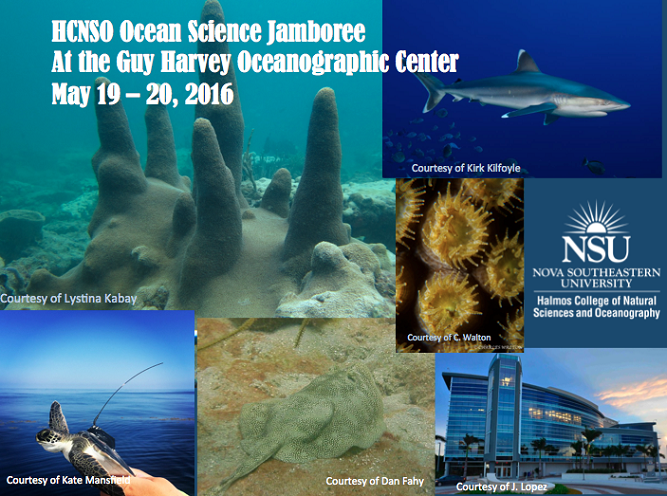Biomixing Due to Diel Vertical Migrations of Zooplankton: Comparison of Computational Fluid Dynamics Model with Observations
Location
Guy Harvey Oceanographic Center Facility
Start
5-20-2016 2:45 PM
End
5-20-2016 3:00 PM
Abstract
Recent studies suggest that diel vertical migrations (DVM) of zooplankton may have an impact on ocean mixing, though details are not completely clear. Kunze et al. (2006) reported an increase of dissipation rate of turbulent kinetic energy, ε, by four to five orders of magnitude during DVM of zooplankton over background turbulence in Saanich Inlet, British Columbia, Canada. However, the effect was not observed in the same area by Rousseau et al. (2010) and was later reassessed by Kunze (2011). In our work, an 11-month data set obtained in the Straits of Florida with a bottom-mounted acoustic Doppler current profiler revealed strong sound scattering layers undergoing DVM. We used a 3-D non-hydrostatic computational fluid dynamics model with Lagrangian particle injections (a proxy for migrating organisms) via a discrete phase model to simulate the effect of turbulence generation by DVM. We tested a range of organism concentrations from 1000 to 10,000 organisms/m3 based on measurements by Greenlaw (1979) and Mackie and Mills (1983) in Saanich Inlet. At a concentration close to the upper limit, the simulation showed an increase in ε by two to three orders of magnitude during DVM over background turbulence, 10-9 W kg-1. At a concentration of 1000 organisms/m3, almost no turbulence above the background level was produced in the model. These results suggest that the Kunze et al. (2006) observations could have been performed at a larger concentration of migrating zooplankton than those reported by Rousseau et al. (2010). No exact zooplankton concentrations data were provided in either work. The difference between observations and the model can, in part, be explained by the fact that Kunze et al. (2006) measured instantaneous profiles of ε, while the model results on ε were averaged horizontally over the 50 m by 50 m domain. In the Straits of Florida, we observed a small decrease in northward current velocity profiles during migration times after averaging over 11 months of observations. The computational fluid dynamics model reproduced this decrease of current velocity due to turbulence generated by DVM in the Straits of Florida model case. The deviations in the velocity profiles can be explained by the increase in turbulent mixing during vertical migration periods. Comparison of observational data to the model results was complicated by physical factors such as tides, Florida Current meandering, etc., which may have a stronger effect on current velocity profiles than DVM.
Biomixing Due to Diel Vertical Migrations of Zooplankton: Comparison of Computational Fluid Dynamics Model with Observations
Guy Harvey Oceanographic Center Facility
Recent studies suggest that diel vertical migrations (DVM) of zooplankton may have an impact on ocean mixing, though details are not completely clear. Kunze et al. (2006) reported an increase of dissipation rate of turbulent kinetic energy, ε, by four to five orders of magnitude during DVM of zooplankton over background turbulence in Saanich Inlet, British Columbia, Canada. However, the effect was not observed in the same area by Rousseau et al. (2010) and was later reassessed by Kunze (2011). In our work, an 11-month data set obtained in the Straits of Florida with a bottom-mounted acoustic Doppler current profiler revealed strong sound scattering layers undergoing DVM. We used a 3-D non-hydrostatic computational fluid dynamics model with Lagrangian particle injections (a proxy for migrating organisms) via a discrete phase model to simulate the effect of turbulence generation by DVM. We tested a range of organism concentrations from 1000 to 10,000 organisms/m3 based on measurements by Greenlaw (1979) and Mackie and Mills (1983) in Saanich Inlet. At a concentration close to the upper limit, the simulation showed an increase in ε by two to three orders of magnitude during DVM over background turbulence, 10-9 W kg-1. At a concentration of 1000 organisms/m3, almost no turbulence above the background level was produced in the model. These results suggest that the Kunze et al. (2006) observations could have been performed at a larger concentration of migrating zooplankton than those reported by Rousseau et al. (2010). No exact zooplankton concentrations data were provided in either work. The difference between observations and the model can, in part, be explained by the fact that Kunze et al. (2006) measured instantaneous profiles of ε, while the model results on ε were averaged horizontally over the 50 m by 50 m domain. In the Straits of Florida, we observed a small decrease in northward current velocity profiles during migration times after averaging over 11 months of observations. The computational fluid dynamics model reproduced this decrease of current velocity due to turbulence generated by DVM in the Straits of Florida model case. The deviations in the velocity profiles can be explained by the increase in turbulent mixing during vertical migration periods. Comparison of observational data to the model results was complicated by physical factors such as tides, Florida Current meandering, etc., which may have a stronger effect on current velocity profiles than DVM.


